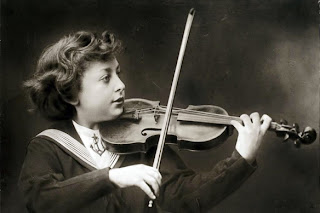His name was Heifetz-- never Jascha. Only those closest to him were permitted to call him Jim, but I did not know him. Heifetz was born “Joseph Heifetz” in Vilna, Russian Lithuania, on 2 February 1901. His mother later changed his name to Jascha, which after a couple of translations, is Joseph.
 |
| Heifetz, about age 7 |
Heifetz’s mother and father thrusted the violin on him at the age of three and was soon enrolled into the local music academy. This is the only schooling he earned a degree in, as he saw them as a waste of time.His father, Ruben, always hassled him with his playing, even when he was a world famous violinist.
Heifetz claimed to have made his debut at age seven. He liked playing the violin a lot, and his specialty piece was Richard Strauss’s Violin Sonata in E-flat major, Op. 18, a piece he played so often it seemed to be his own. He got into trouble playing it in Israel in 1953 with the minister since Strauss had been considered a Nazi sympathizer. Naturally Heifetz ignored the warnings and played it twice. It got him a scar on his arm, as he was attacked later that night, but he wasn’t majorly hurt..
Heifetz was a man that everyone knew of. He played music his entire life until he was seventy, which then he retired to teach it. He taught sixteen years before his death. Ayke Agus, his closest companion, was one of the only people who got close to him during his life. She brought him out of his shell. Heifetz complimented her once, on their first encounter, and she didn’t answer him, so he continuously shouted at her. She still didn’t answer him, so he said “You know, I don’t compliment everyone.” His stature had been stiff, the same as when he plays his violin, but this time he was angry. His entire demeanor in one second. Heifetz had grown up to be a judgy, cold old man, just as his father had been.
 |
| Heifetz and Agus with students |
Heifetz played the violin religiously throughout his entire life. He always strived to be the best and his father pushed him even further. He played many concerts and venues, including Carnegie Hall, and was declared “a violinist who raised performance standards to heights that were before him not even considered to be possible”. He retired at seventy to teach music at USC. He didn’t accept applications for students who only wanted a degree. To him, education should never define who you are.
Heifetz learned to keep people at a safe distance, which had them all wondering who he really was. Even nowadays, 27 years after his death, we know little about “God’s Fiddler”. Peter Rosen, a man who approached a documentary project for him, once said “I was amazed that there was no other documentary in the world about Heifetz, but I didn’t think there was a story with Heifetz.” Ayke Agus, the woman responsible for “Heifetz as I Knew Him”, saw more in him than anyone else in the entire world, which was why she was deemed worthy enough to call him Jim; why she was his companion pianist and violinist.
Meeting Ayke Agus was very important for Heifetz. He met his other half. He once said “If only you had been born earlier, or I later; we could've had a long life together.” Heifetz didn’t get close with anyone, but there was that small connection with Agus, his accompanying musician.
 |
| Heifetz at a younger age |
Heifetz was thought to have played the violin too stiffly, as the violin was a flowing instrument and he didn't flow with it. There are documentations of him playing a specific venues, but they were recorded for the way he played. His father always pushed him for better when he was younger,and I think the reason he plays so stiffly is because his teacher, which was his father, focussed more on playing than posture. Judges tend to focus on the musicality of the musician. Heifetz and his father’s relationship was strained, but with Heifetz travelling the world to play, it was bearable. After he retired to teach, he turned into a scarcely impressed man, but after Agus came into his life, he was smiling and laughing more.
 |
| Heifetz smiling |
Heifetz’s reason for fame is different to many people. In his 65 years of playing the violin, he played for Allied servicemen and women during World War II in Europe, mostly in the back of trucks. He also led efforts to make “911” an Emergency hotline. He and his USC students protested smog. He converted his car into an electric car.He published many of his own songs, even one in 1946 under the pseudonym “Jim Hoyle. The song? “When You Make Love To Me (Don’t Make Believe)”. His music is no less impressive nor influential nowadays as it was in his time, and I, along with countless others who look up to him, will always refer to him as “The King.”
Heifetz married twice in his life; his first wife was Florence Vidor and his second was Frances Spiegelberg. He had three children total; Josefa, Robert, and Jay.He didn’t stay with either wife. He loved teaching at USC and also loved ping pong, sailing, and collecting stamps. His death came to him on 10 December 1987, in Cedar-Sinai Medical Center in Los Angeles, California.
Heifetz was thought to have been the best musician of his and our lifetimes. It was once said that there was only person he tried to beat and that person was Jascha Heifetz.
No comments:
Post a Comment